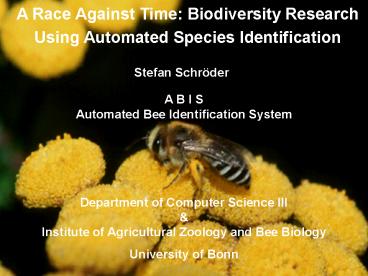Stefan Schrder - PowerPoint PPT Presentation
1 / 24
Title:
Stefan Schrder
Description:
... {l|l}l~l l l l l l lrlll lel lcldl lel lLl lclCl l lnlulul ?l l l ?lLlAlPl ... 2 OeW PNG. IHDR *RZ*PLTEB5 B? B?DBIDBILJSLJSUJS]J]LRSUR]UR]]R]eRqnZ? ZI ... – PowerPoint PPT presentation
Number of Views:30
Avg rating:3.0/5.0
Title: Stefan Schrder
1
A Race Against Time Biodiversity Research Using
Automated Species Identification
- Stefan Schröder
A B I S Automated Bee Identification
System Department of Computer Science III
Institute of Agricultural Zoology and Bee
Biology University of Bonn
2
Bees fascinating, highly diverse, widely unknown,
ecologically and economically important
- 17.000 known species, 30.000 estimated
- in Germany, for example 50 of the 550 species
are endangered
3
Pollination is essential for human well-being
- more than 70 of the worlds crops demand bee
pollination - a crucial ecological and economical resource, but
bee populations throughout the world are in
decline - annual value of the service of pollination has
been reported to be between 65 and 70 billion US
4
Biodiversity research A race against time
- Edward O. Wilson, Harvard University
- 27,000 species extinct per year
- National Research Council
- 50 of all current species may already be
extinct by 2100
5
A global problem in entomologyThe taxonomical
impediment
We can only monitor and conserve those animals
that we know. Studies on bee diversity, on
conservation and on pollination ecology are
hampered by
- the difficult taxonomy of bees,
- the current lack of taxonomical experts,
- and, as a consequence, the lack of classification
literature such as modern identification keys and
actual revisions.
Christopher OToole, the Natural History Museum
in Oxford Bee systematics in Europe is in a
dire state.
6
ABIS - Automated Bee Identification System
Image Acquisition
Identification
Image processing
7
Patterns of wing venation
different genera
Bombus
Colletes
Anthidium
A. manicatum
C. similis
B. cryptarum
different species
A. punctatum
B. lucorum
C. nigricans
B. lapidarius
A. strigatum
C. marginatus
8
Automatic Image Processing
9
Automatic Image Processing
10
Automatic Image Processing
11
Automatic Image Processing
12
Automatic Image Processing
13
Automatic Image Processing
14
Automatic Image Processing
15
Automatic Image Processing
16
Identification of species without training, no
identification
Training
Identification
- The method achieved identification rates of above
95 , often better than 98 . - The minimum training set for closely related
species was 30 correctly identified specimens per
species.
17
Dimensions of Application
Investigations on Species Biology and
Pollination Ecology
Support of Bee Systematics
Survey and Monitoring
Network
18
Support of Bee Systematics
19
Survey and Monitoring
If we can identify bees, we are then able to
monitor them.
20
ABIS Network
- ABIS is part of the national EDIS project
(Entomological Data Information System) - ABIS shares GBIFs goal of making the worlds
biodiversity data freely and universally
available and is therefore part of the
international GBIF network.
21
Investigations on Species Biology and
Pollination Ecology
22
Whats next with ABIS?
23
Acknowledgement
... and the other hard-working bees of the ABIS
project
Institute of Agricultural Zoology University of
Bonn
Institute of Computer Science III University of
Bonn
Prof. Dr. Armin B. Cremers Priv. Doz. Dr. Volker
Steinhage Dr. Volker Roth Dr. Tom
Arbuckle Arthur Pogoda Susanne Meyfarth Thomas
Scharrenbach
Prof. Dr. Dieter Wittmann Prof. Dr. Wilhelm
Drescher Christiane Botta Axel Heck Jutta
Krawinkel Renate Tietz
- early work on ABIS was funded by the German
Science Foundation (DFG)
- ABIS is currently funded by the German Federal
Ministry of Education and Research (BMBF)
24
(No Transcript)































